yamaha
MXA RACE TEST: 2017 YAMAHA YZ250: HEADED TO DIVORCE COURT
Click on images to enlarge
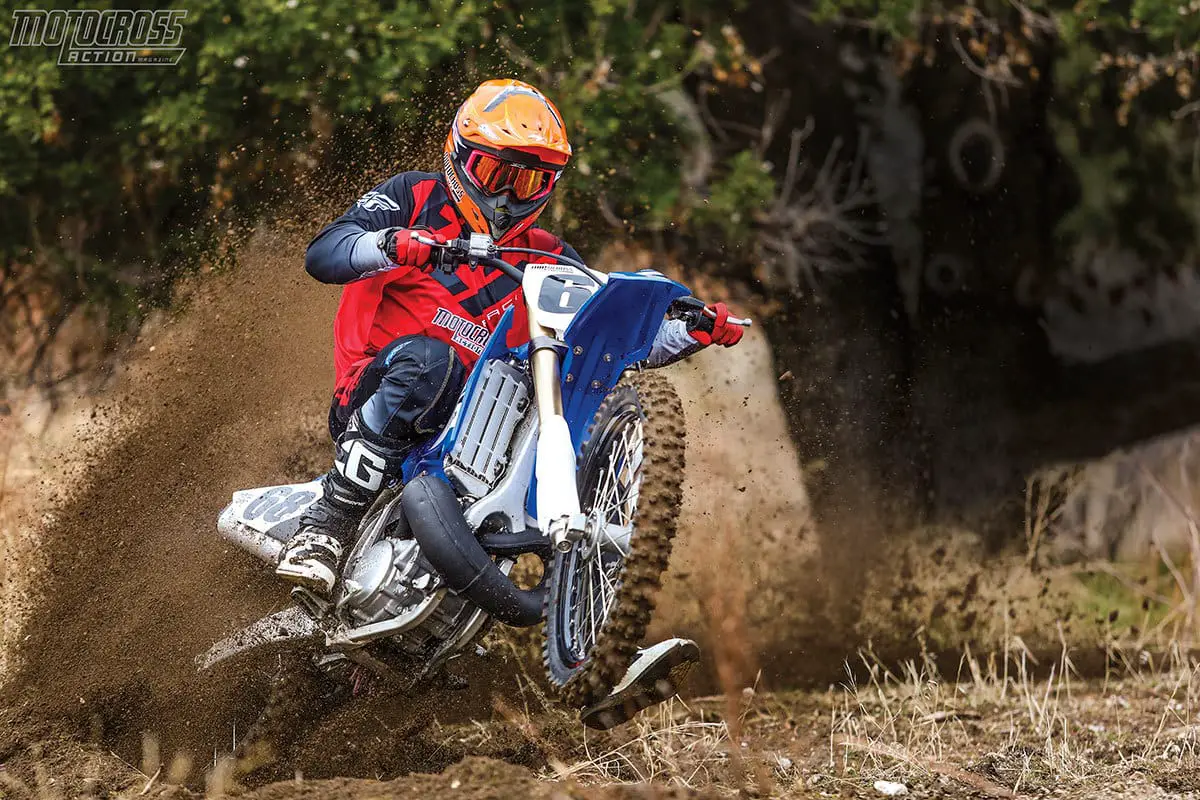
Can you teach an old dog new tricks? Not this decade-old smoker. This old dog needs more than a new chew toy. It needs to step into modern times.
Instead of asking the same old question, “What changes have been made to the 2017 Yamaha YZ250?” We are going to ask, “What changes need to be made to the 2018 Yamaha YZ250,” because otherwise we will be running the exact same test every year in MXA for as long as the top brass continue to pop out more Xerox copies of the same-old YZ250. This is especially true of the 2017 Yamaha YZ250, which is identical to the 2016 YZ250—save for Bold New Graphics (BNG) and bigger front rotor. At least Yamaha changed the graphics. Honda didn’t even give the 2017 Honda CRF250 a courtesy sticker. So kudos to Yamaha for the BNG, but customers aren’t going to be thrilled to pay $109 more for updated radiator decals.
In 2016 MXA built lots of Yamaha YZ250 project bikes based on older-model YZ250s. We rebuilt the engines, updated the suspension and even made them look like the current showroom YZ250s. How is it possible that everything on a 2017 YZ250 can still bolt on to an 11-year-old YZ250—save for the front fender? Even more shocking, when test riders rode the new model and the old model back to back, they couldn’t tell which one was new and which one was celebrating its 10th birthday. Most of the time they preferred the older model because of its re-valved suspension and aftermarket pipe.
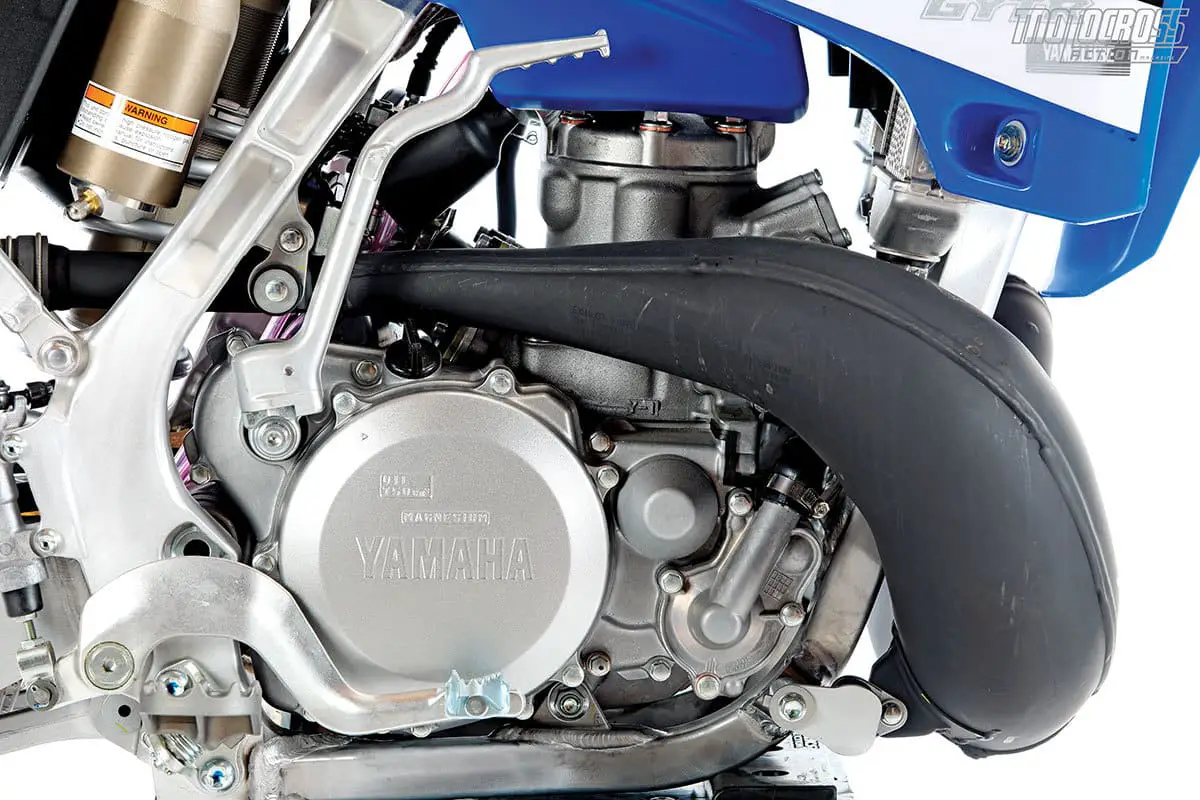
The YZ250 engine was ahead of its time ten years ago. Now it is behind the times due to the ever-improving KTM 250SX.
Yamaha’s marketing strategy with the YZ250 two-stroke is a recipe for disaster. Why? Because any year Yamaha YZ250—from 2006 to 2017—is the victim of benign neglect. That is testimony to just how good the Yamaha YZ250s of 2006 on up were, but it begs the question, why would a consumer pay $7399 for a 2017 YZ250 when he can buy a used 10-year-old YZ250 that has the same chassis, suspension and engine for half the price? And have the exat same bike—give or take a few doo-dads.
MXA likes to say that the best-selling motocross bike of all time is the Yamaha YZ250 two-stroke, or, more accurately, that used YZ250s are the best-selling bikes because they have been sold and resold over and over again. It is hard to believe that Yamaha’s product managers are unaware of the success that KTM has had with its two-stroke line. The Austrian brand, with the added production quantities from sister brand Husqvarna, sells more two-strokes than Yamaha sells four-strokes. KTM has never slowed its two-stroke R&D. If you put a 2006 KTM 250SX next to a 2017 KTM 250SX, you’d think that the old one was a vintage bike. Not so with the Yamaha YZ250. Look where the money that KTM invested in its two-stroke product line has brought the KTM brand.
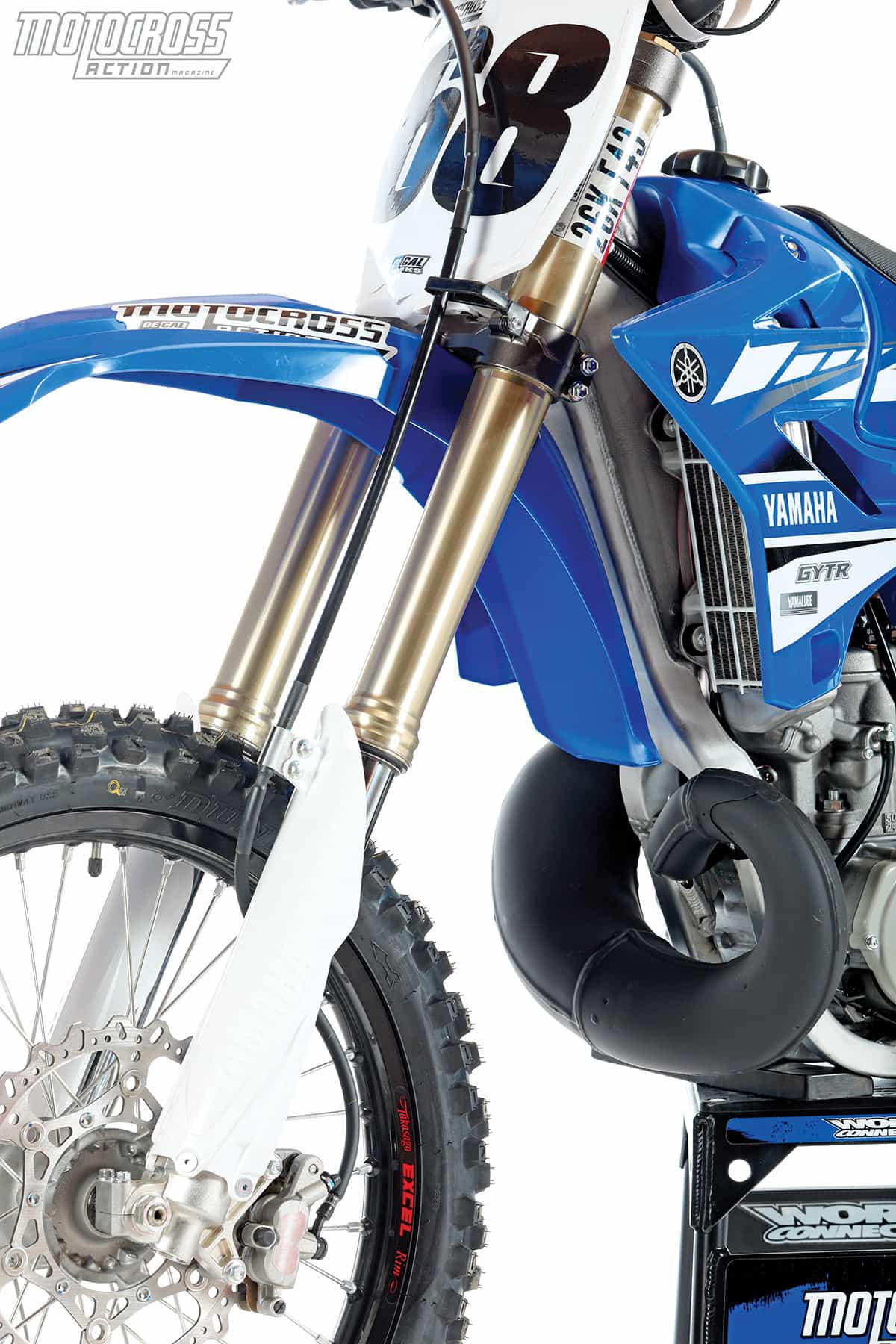
Yamaha needs to update every part on their YZ250, save for the Kayaba SSS spring forks. They still are a step ahead.
Okay, maybe we are being too hard on Yamaha. After all, Yamaha didn’t turn tail and run when the four-stroke craze wiped out two-stroke sales overnight. They kept producing two-strokes when Honda, Suzuki and Kawasaki threw in the towel. But, they weren’t true believers. They just produced enough two-strokes to supply dealer demand, and, of course, dealer demand decreases every time the latest Xeroxed Yamaha YZ250 is released. We don’t know what’s going on behind closed doors at Yamaha’s factory. Maybe they have wonderful things planned for the future, but that obviously didn’t include the 2017 Yamaha YZ250.
Is there a fix for the doldrums that the YZ250 has fallen into? Heck yes. All Yamaha has to do is copy KTM’s business model. KTM doesn’t hide the fact that its 250cc and 300cc two-stroke engines are the best-selling powerplants in its vast fleet of bikes. KTM exalts the two-stroke, while Yamaha seems to be running on autopilot. Want a fuel-injected two-stroke? KTM has one, Yamah doesn’t. KTM has proven that there is a big piece of pie up for grabs—and we know that Honda, Suzuki and Kawasaki won’t bite into it.
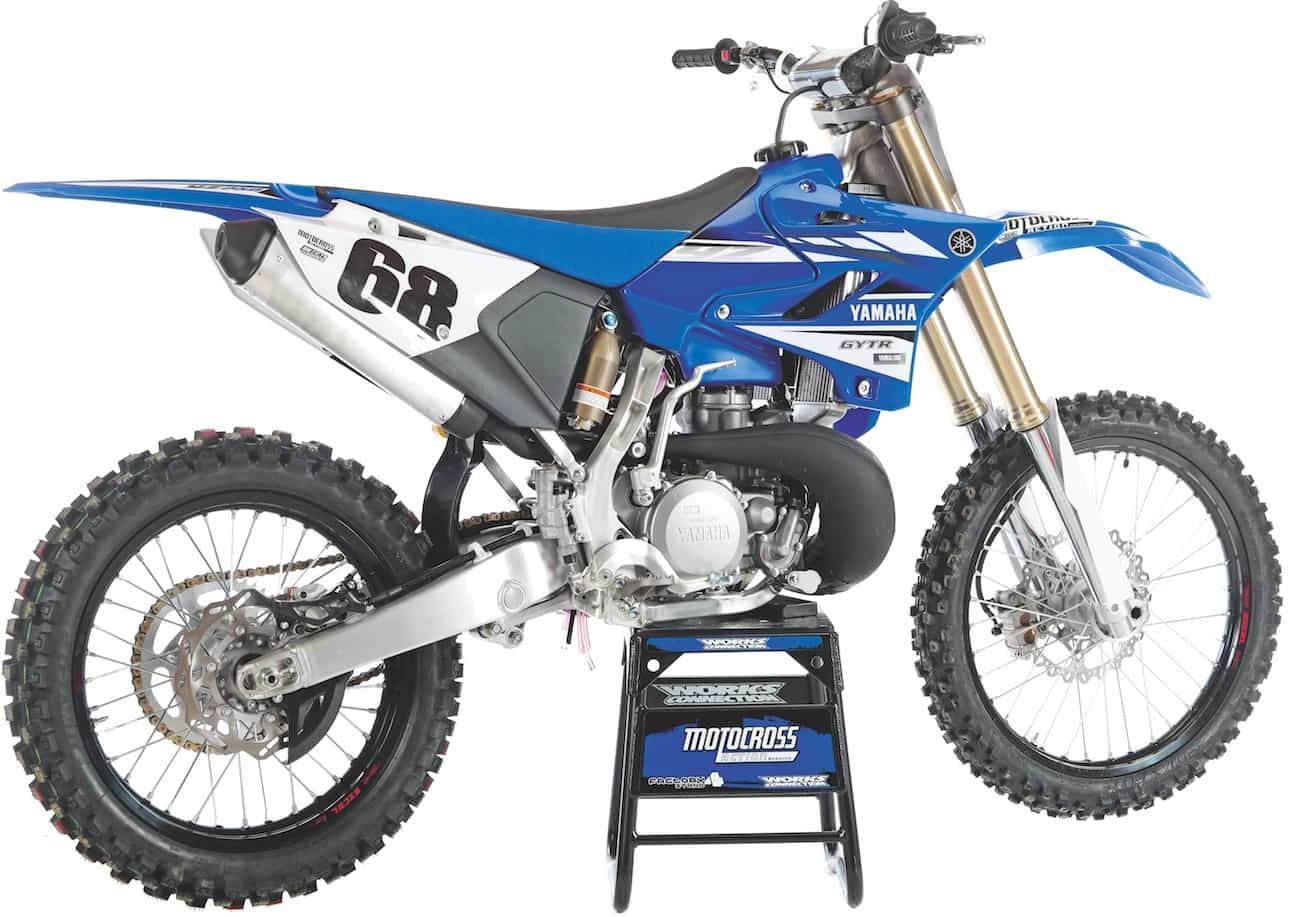
It wouldn’t take much work or money to make the YZ250 competitive once again. Just copy a Pro Circuit pipe, add a modern reed cage and beef up the flywheel weight to give it an improved, all-around spread.
Believe us, MXA doesn’t like bashing the YZ250. We love this bike. It has been loyal to us. It has been steady, predictable and reliable. We have shared a lot of quality time together. However, if the trend of the last 10 years continues, we are headed for divorce court. We can’t grow old together without change.
Change is what motocross development is all about. Look at where the four-stroke was 10 years ago in terms of weight, power, reliability and handling. Now look at where it is today. Now imagine that the 2017 Yamaha YZ250 was the benefactor of the same slavish devotion to research and development as the Yamaha four-strokes. To that end, here are several things that Yamaha should consider doing to the 2018 YZ250. Here’s a list—that we are sure that any loyal two-stroke guy could add to in a second.

This is what the YZ250 two-stroke does best. You can fling it around a racetrack, wheelie out of corners and slide the rear end like Mert Lawwill.
(1) MAKE THE POWERPLANT COMPETITIVE WITHOUT BREAKING THE BANK
At 47.10 horsepower and 30.6 foot-pounds of torque, the Yamaha doesn’t have horrible numbers for an engine that has remained stagnant for more than a decade. It has a broad, fun-to-ride powerband that suits any occasion. Whether it’s on a motocross track, plonking through the woods or play riding in the hills, the YZ250 engine has a do-it-all powerband that gets the job done. On the other hand, it is hard to ignore the potent powerplant of its competition. The 2017 KTM 250SX comes in at 47.21 horsepower (with 32.81 foot-pounds of torque). On paper, it doesn’t look like a significant difference. But, the KTM puts out five more horses than the YZ250 from 6000 to 7500 rpm. We won’t lie; it is a wild ride. It hits hard in the midrange and rocks you back in the saddle. It is a race engine, but one with vibration-reducing counterbalancers, a compact size and faultless hydraulic clutch. And, you can even get an electric starter for it.
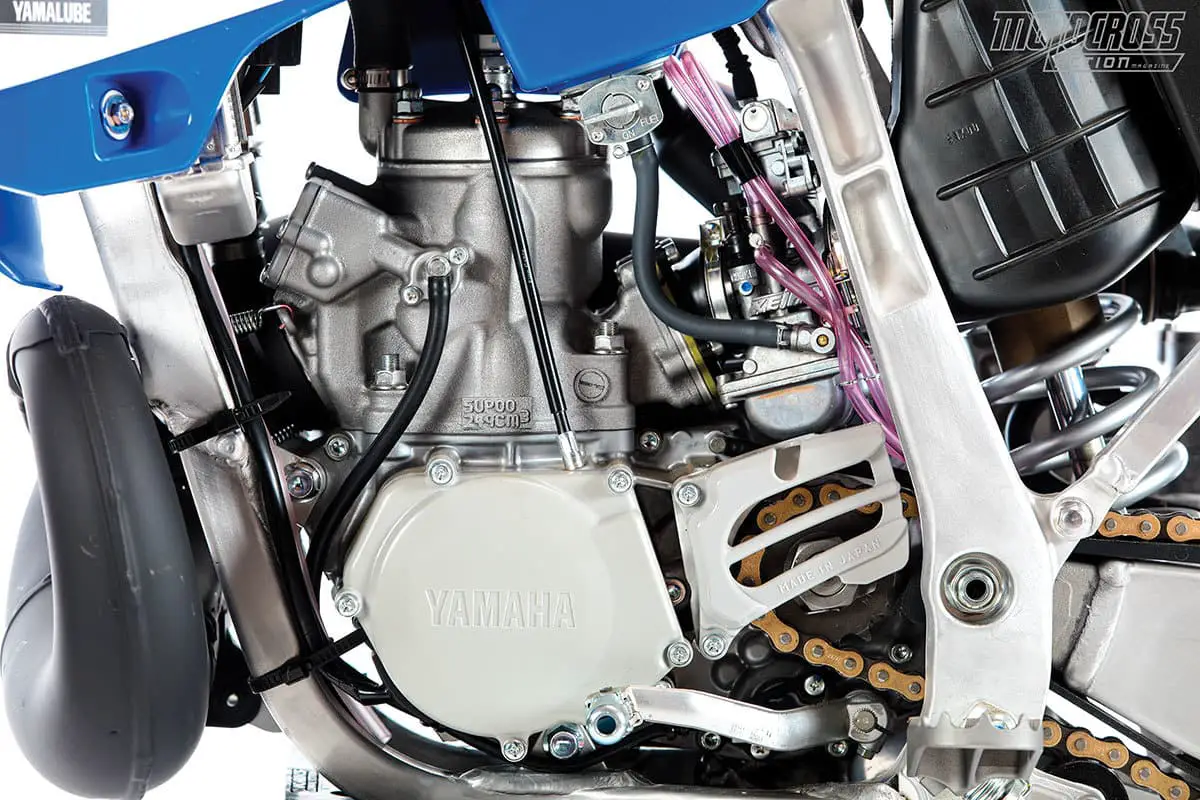
The longer the YZ250 has gone without change, the further it has drifted away from the new bike market.
It wouldn’t take much for the YZ250 powerplant to be competitive against the KTM 250SX. Hear us out. Yamaha could keep the basic bones of the existing engine and simply add a copy of a Pro Circuit pipe and silencer. Right off the bat, Yamaha would gain 2 solid horsepower and over 1 foot-pound of torque. Next, Yamaha could make a deal, as KTM did a few years ago, to run an aftermarket reed cage. The payoff would be improved throttle response and midrange. What about getting the power to the ground? A heavier flywheel weight is the proof in the pudding. All the Yamaha factory YZ250 riders back in the day ran one. But, we don’t even need to go that far, because the KTM 250SX needs one as well.
If these few minor, low-cost changes can make a YZ250 stronger, faster and more competitive, think what Yamaha could achieve with a totally new engine.
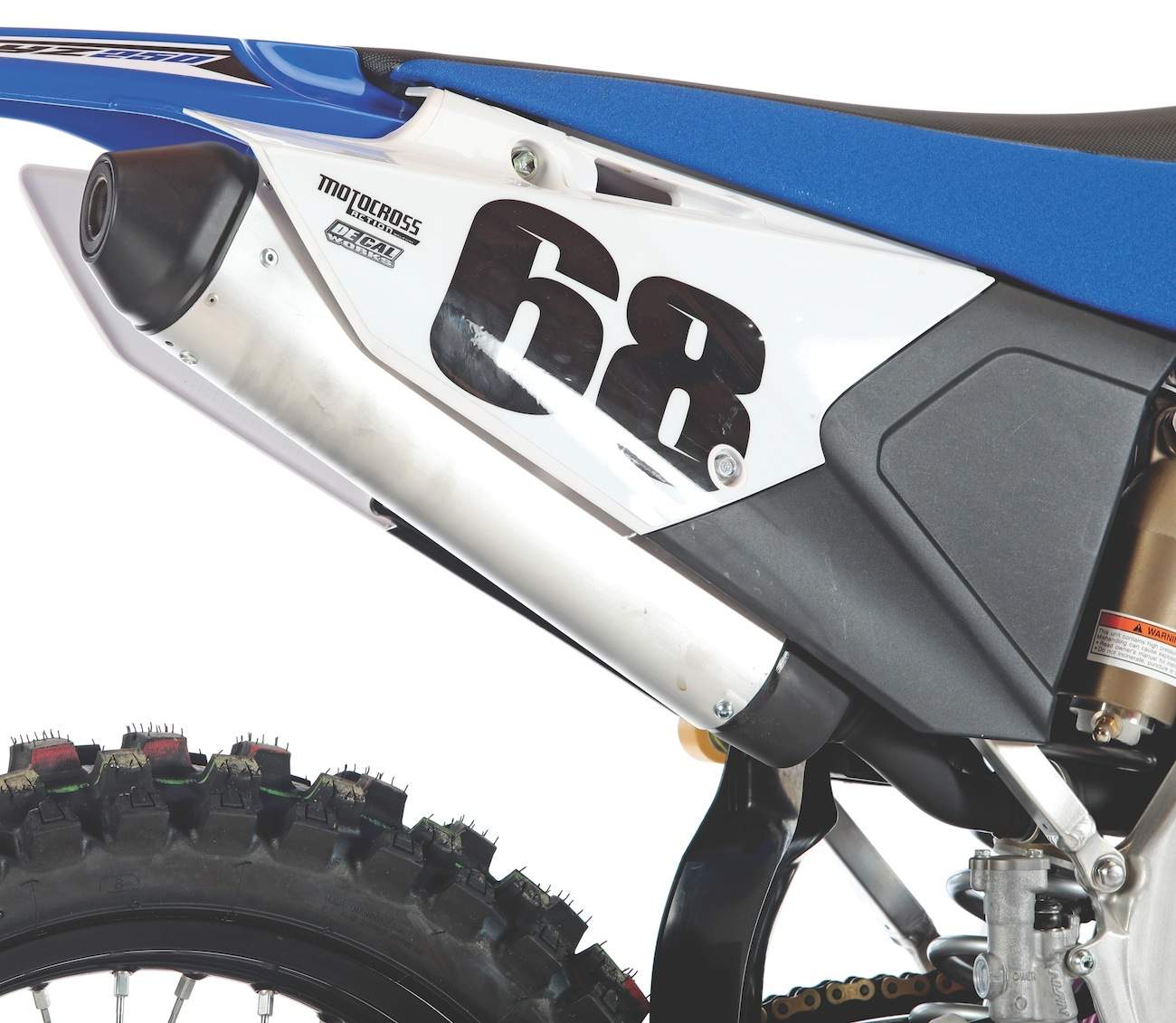
Fuel injection is always the go-to Mr. Fix-It of everything that ails the motorcycle world, but Yamaha needs to forget it, except in the enduro world where the strict Euro-4 emission standards are what KTM act on their almost decade old EFI two-stroke. There is no guarantee that a fuel-injected two-stroke engine will have the charm, simplicity, raw horsepower or fuel-on-demand usability of a carbureted two-stroke. But, we can guarantee that it will raise the price, weight and complexity of a two-stroke engine and make it harder for the backyard mechanic to work on.
It is the ease of maintenance that has kept the Yamaha YZ250 around all these years. Any guy with a nutcracker and a bottle opener can change the top end on a YZ250 for a couple hundred dollars in parts. Let’s not lose that in pursuit of some technical nirvana.
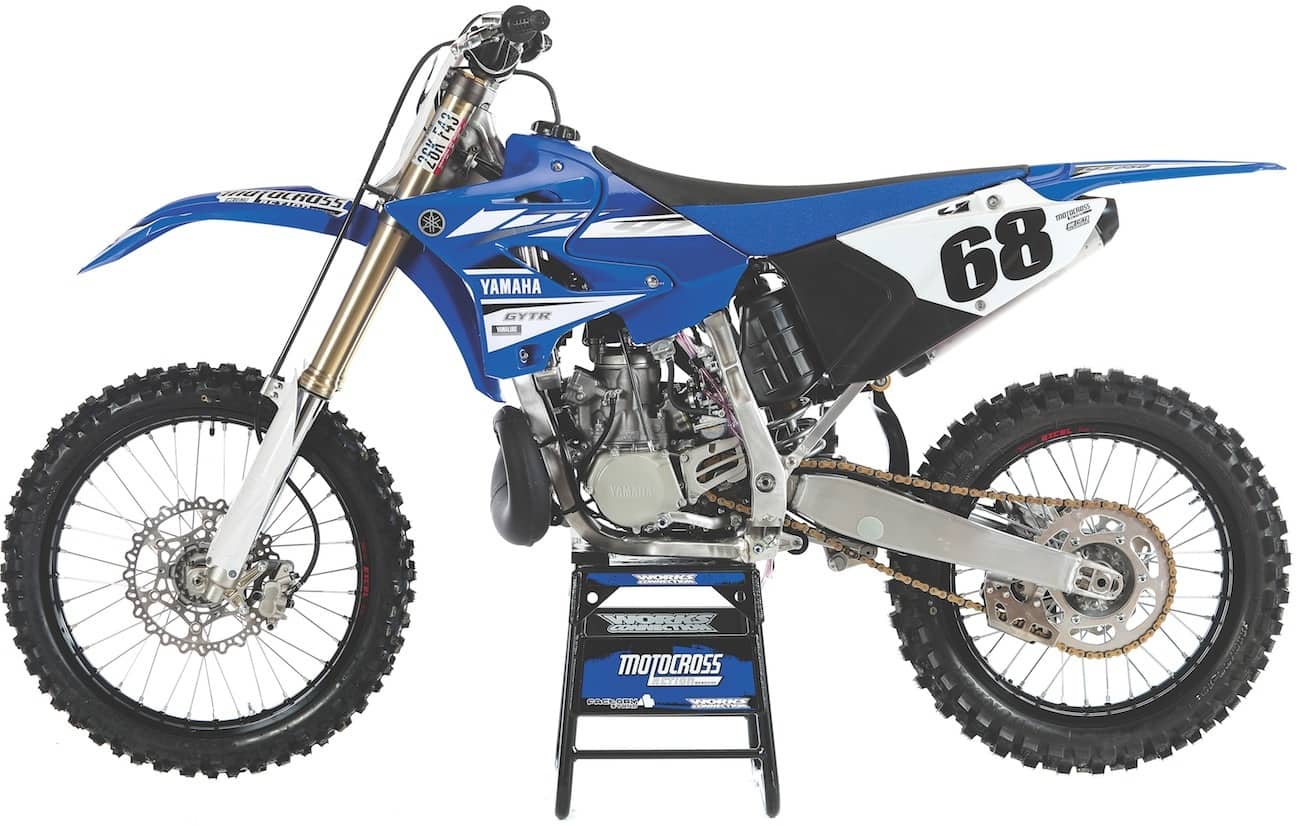
The YZ250 got a plastics update a few years ago, but it just kept up with the aftermarket plastic companies who came out with it first.
(3) BUILD A CHASSIS WITH THE HANDLING CAPABILITIES OF THE LATEST KTM
This is where Yamaha is going to have real trouble. We can turn a blind eye to the engine, because we can fix it ourselves with some aftermarket parts. But, we can’t fix handling with Band-Aids. For its time, back when the Bushes were in the White House, the YZ250 chassis was as good as it got as an all-around-handling package. But, in the long, dry, fallow years since this chassis was designed, it has been overshadowed by its lone competitor. The YZ250 has always been a middle-of-the-road-handling machine. It doesn’t do anything wrong, but it doesn’t do anything especially right, either. Even back in the day, the now-defunct Suzuki RM250 could turn better and the Honda CR250 had better ergonomics. Now, in 2017, it has met a more formidable foe in a KTM 250SX that does everything right.
And not to hurt the feelings of the Yamaha engineers any more than necessary, but the 2017 KTM 250SX weighs 211 pounds. That is 7 pounds lighter than the Yamaha YZ250, which was once considered to be a lightweight (back when 450 four-strokes weighed 242 pounds). Now the YZ250 weighs the same as a KTM 250SXF—the four-stroke version.
Yamaha’s first step would be to work on some frame dimensions that enhance steering response on the entrance to turns and deliver a lighter, more agile feel. Perhaps Yamaha could borrow a page from the Service Honda CR500AF and start stuffing YZ250 engines into 2013 Yamaha YZ250F frames to get a taste of whether they have something already in the inventory that could work. They’d have to go back to the 2013 frame, because the newer-model Yamaha four-strokes have reverse engines.
No matter what its chassis strategy, Yamaha needs to step up to the plate in the handling department.
(4) STICK WITH KAYABA SSS SUSPENSION COMPONENTS
Don’t change a thing with the suspension. It won’t be long before every motorcycle manufacturer will reevaluate its flawed commitment to air forks, save for KTM, who has found the magic elixir with the AER air fork design. Honda has already backed away from PSF-2, and we expect that the 2018 model year will be flush with coil spring forks. When it comes to suspension, this is where Yamaha’s benign neglect looks like an Einstein moment of clarity.
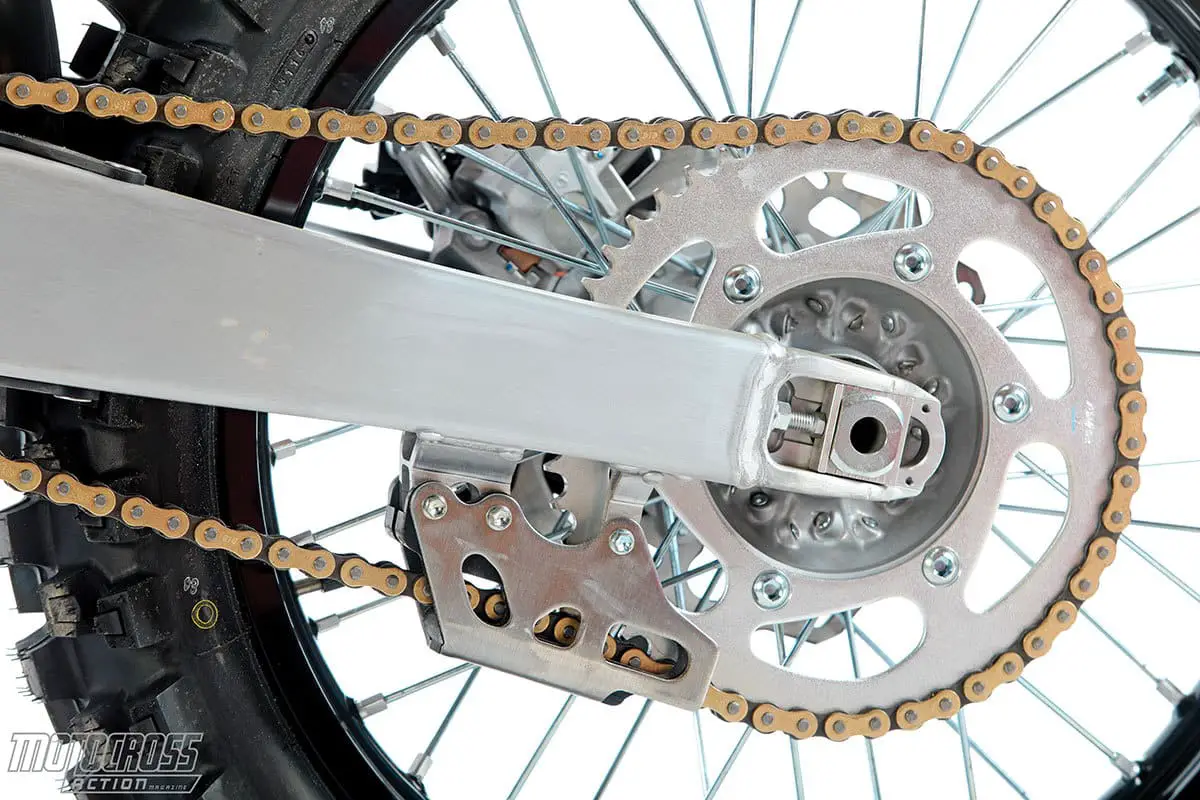
Gear it for what you’re gonna do with it. For motocross racing we add a tooth to close the gap between second and third. If you’re trail rider or a Professional Practice Rider you can ignore this advice.
(5) WORK ON THE PUCKER POWER
You can only go as fast as you can stop. Every motocross racer knows that old adage, but, when it comes to brakes, the Japanese brands are way behind the curve compared to KTM’s Brembo combination. After letting Brembo get miles ahead, the “Big Four” threw oversized 270mm rotors on their bikes to try to close the gap. The big rotors offered more stopping power, but they lacked modulation and were grabby compared to the 260mm Austrian stoppers. Big rotors aren’t the cure-all of iffy brakes. Yamaha, Honda, Kawasaki and eventually Suzuki need new master cylinders, better calipers and improved hydraulics to work in unison with the big rotors.
(6) THE CHEAPEST WAY TO IMPROVE THE YZ250’S HANDLING
When a bike falls out of favor with product managers, the first sign that it is persona non grata at the factory is the tires that come stock on it. The YZ250 is spec’ed with Dunlop MX52 tires. These are the Dunlop models that virtually every brand dropped in 2017 in favor of a Dunlop MX3S or Bridgestone 403/404 combo. The difference in handling performance between a mediocre tire like the MX52 and a premier tire is measured in light years in the motocross world. Plus, Yamaha already specs the Bridgestone 403/404s on its 2017 YZ250F and Dunlop MX3S’ on the YZ450F. Why not put good tires on a bike that need good tires more than it needs cheap rubber.
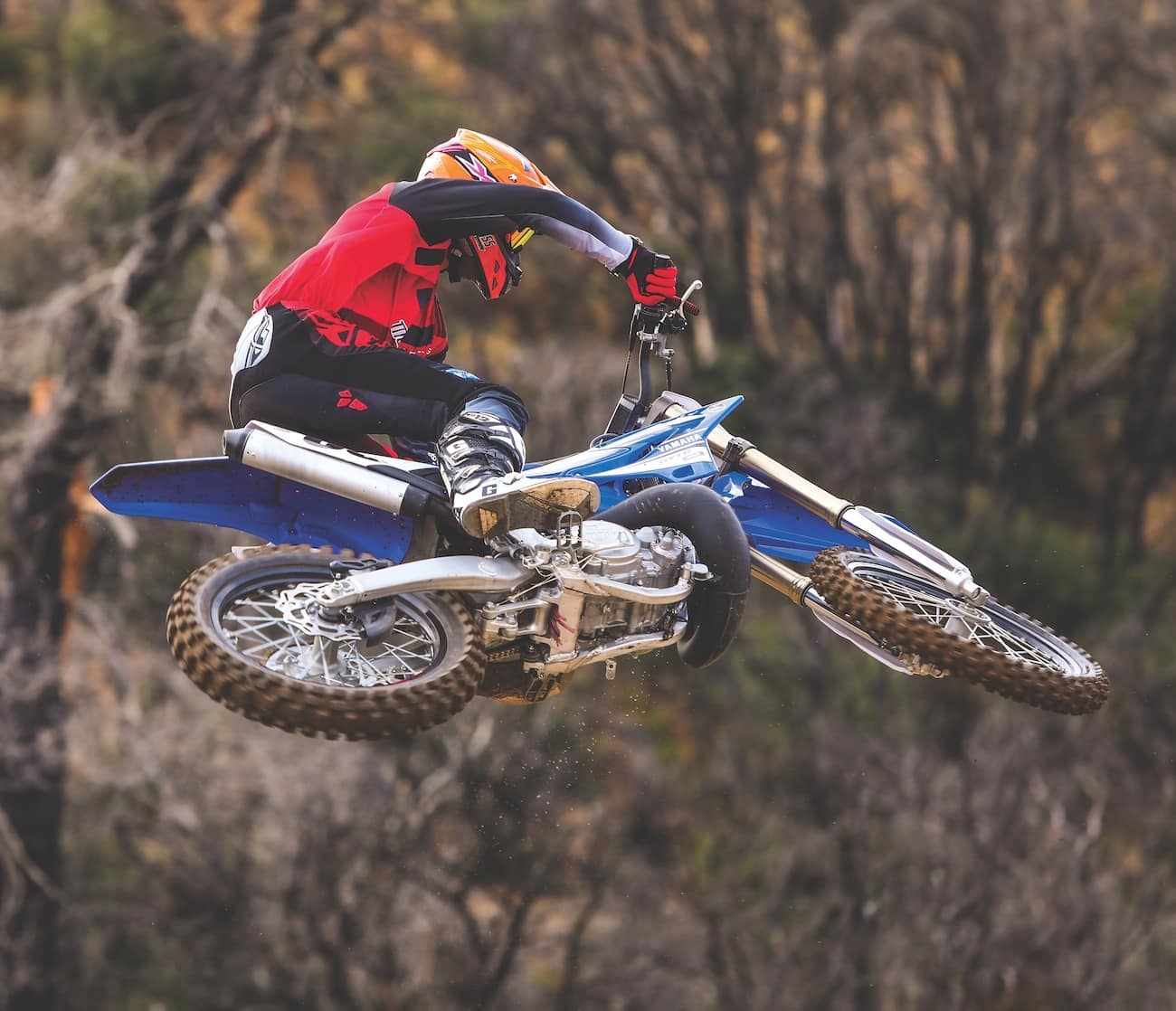
It is obvious that the engineers who built the Yamaha YZ250 were visionary thinkers. It has stood the test of time for almost a decade—and was even winning 250 two-stroke shootouts until a few years ago (largely because of KTM’s pitiful forks). But, Father Time (and KTM’s AER forks) have caught up with it. The YZ250 is still a great bike for the backyard builder to buy on the used-bike market, but on the new-bike market, it has been eclipsed by what KTM and Husqvarna are offering.
The MXA wrecking crew applauds Yamaha for being the last Japanese manufacturer to build a two-stroke line, but we don’t want Yamaha to become the next Japanese manufacturer to drop its two-stroke line. It’s time for Yamaha to show the YZ250 the same amount of love that its loyal devotees do.
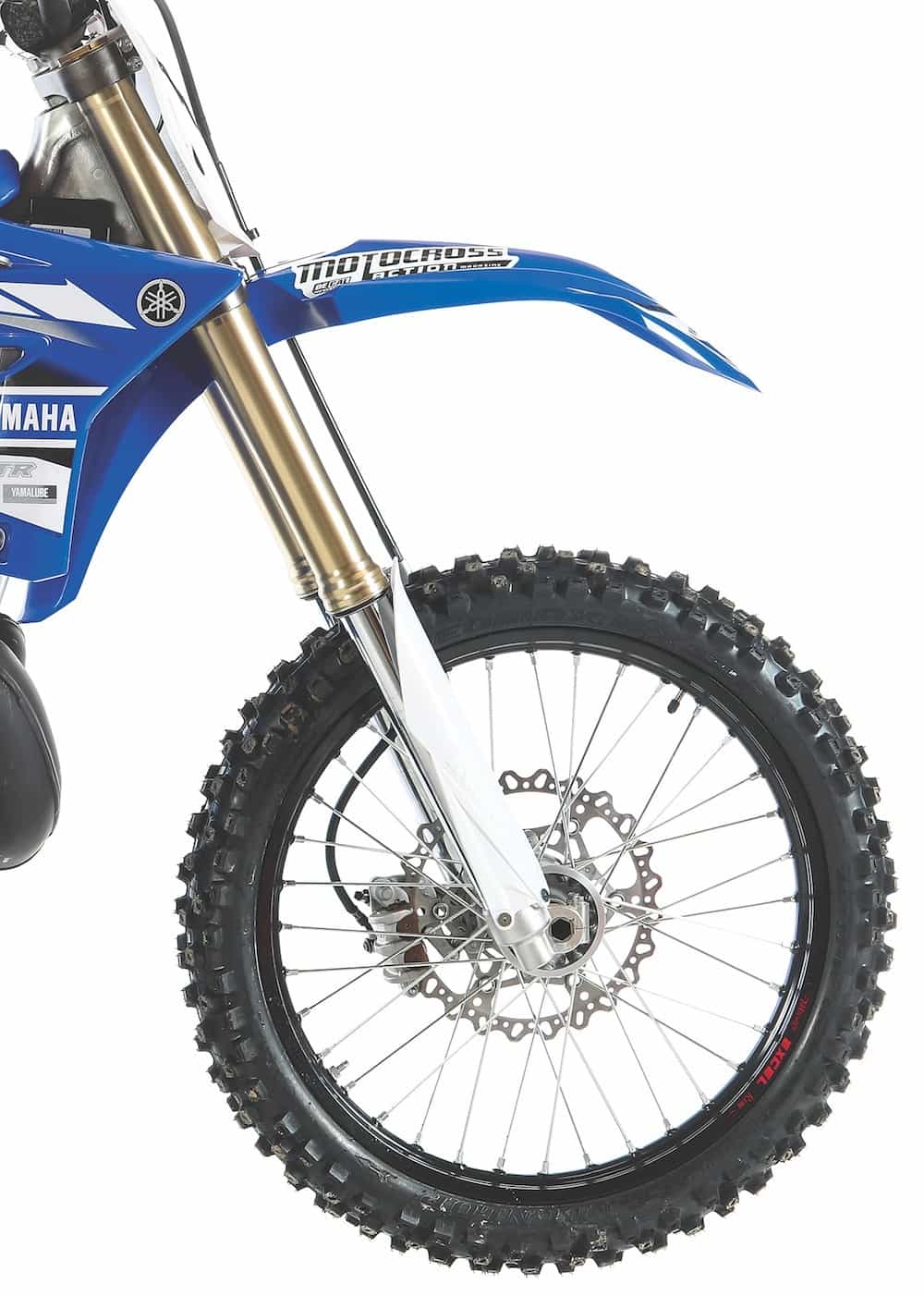 This is how we set up our 2017 Yamaha YZ250 for racing. We offer it as a guide to help you find your own sweet spot.
This is how we set up our 2017 Yamaha YZ250 for racing. We offer it as a guide to help you find your own sweet spot.
KAYABA SSS FORK SETTINGS
Th eonly 11 year-old part on the Yamaha YZ250 that has stood the test of time is the suspension. The Kayaba SSS forks are things of beauty. For hardcore racing, we ran this setup on the 2017 Yamaha YZ250 (stock clickers are in parentheses):Spring rate: 0.43 kg/mmOil height: 330ccCompression: 13 clicks outRebound: 14 clicks outFork-leg height: 5mm up (10mm up)Notes: These are awesome forks, made all the more terrific by the light feel and snappy input of the two-stroke engine. Obviously, if you are fast or fat, you might want to go stiffer on the fork springs. Typically, however, fast riders can dial in more compression and use the crossover effect of rebound damping to get the stock fork springs to work.
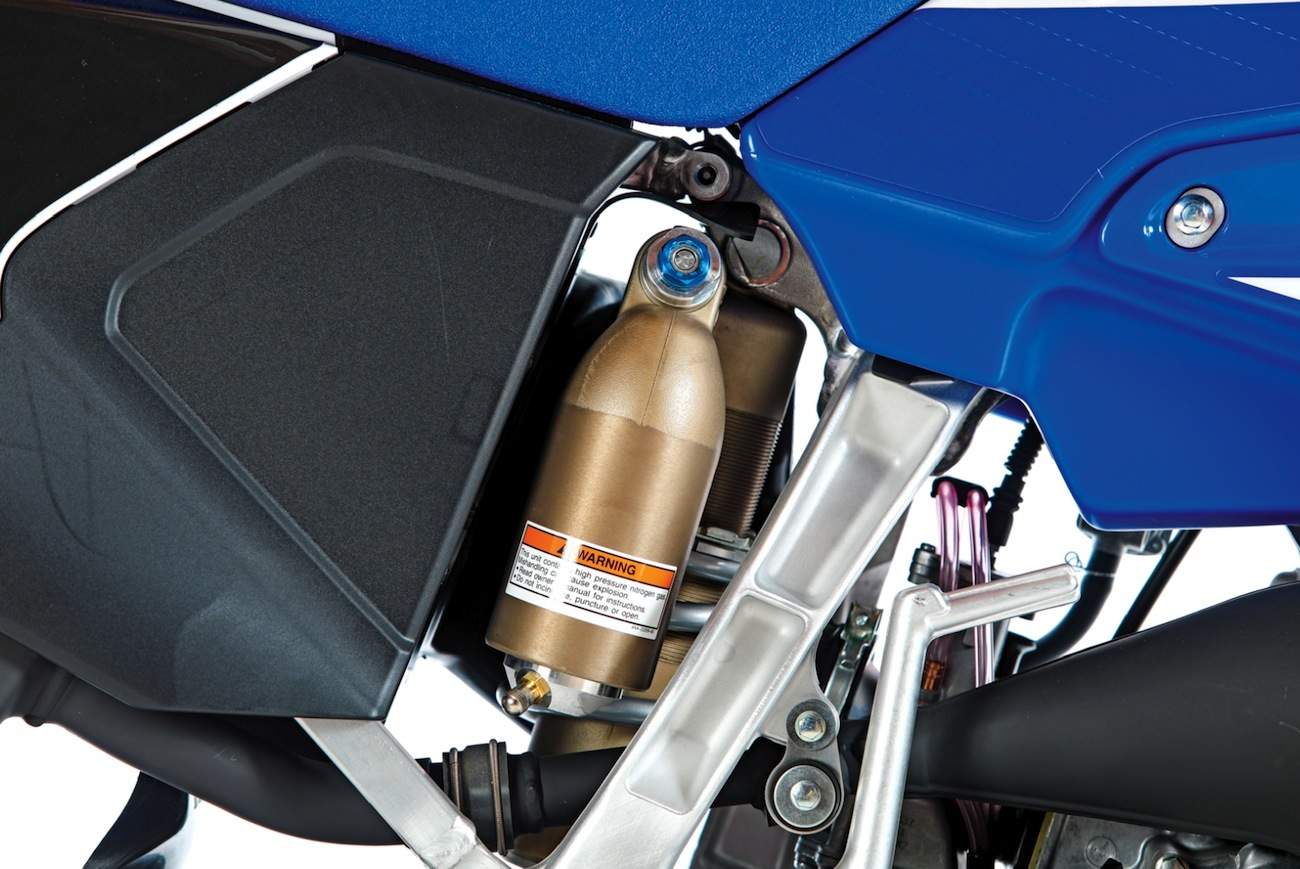
KAYABA SSS SHOCK SETTINGS
For hardcore racing, we ran this setup on the 2017 Yamaha YZ250 (stock clickers are in parentheses):Spring rate: 4.7 kg/mmRace sag: 100mm (105mm)Hi-compression: 1-3/4 turns out (1-1/2 turns out)Lo-compression: 8 clicks out (13 clicks out)Rebound: 8 clicks out (12 clicks out)Notes: The YZ250 shock comes with a jumbo-sized 18mm shock shaft, Kashima-coated internals and SSS damping. AMA National-speed riders and heavyweight contenders will need to move up to a 5.0 kg/mm spring.
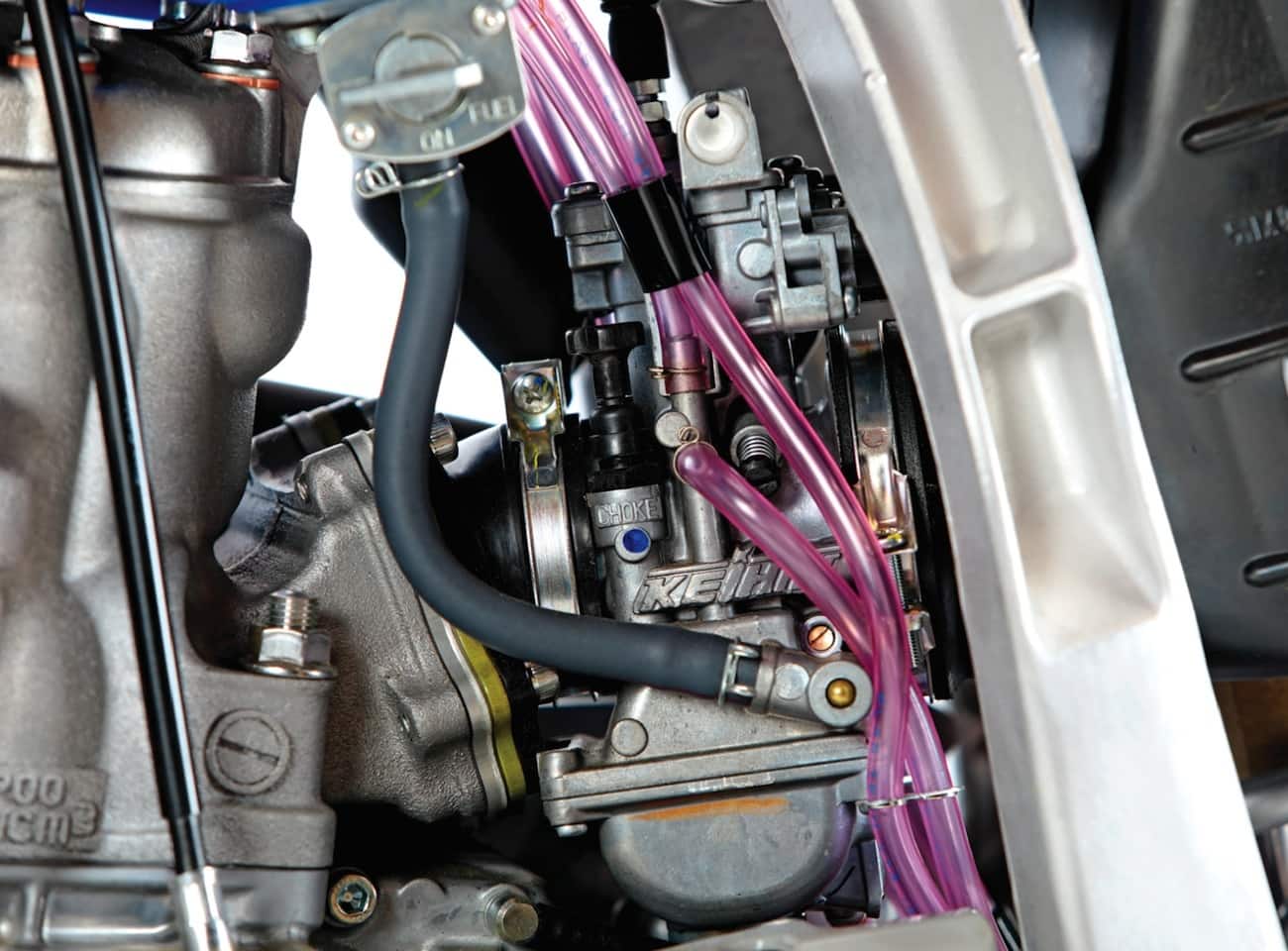
YAMAHA YZ250 JETTING
Jetting is not much of an issue on a bike that has been unchanged for so long. Every hardcore YZ250 racers has his own magic set-up and the stock YZ250 brass is good to go for the stock combination. Here are MXA’s recommended jetting specs (when changed, stock specs are in parentheses):Main: 178Pilot: 50Needle: N3EWClip: 2nd from topAir screw: 1 turnNotes: The 2017 YZ250 jetting is on the edge, albeit the good side of the edge. If you hop-up the YZ250 or add an aftermarket exhaust pipe, you will need to go to a bigger 180 or 182 main. Other than that, the YZ250 jetting is basic, simple and effective. The air screw is very sensitive from 1/2 turn to 1 turn out.

MotoGP: Yamaha Celebrates Its 500th Grand Prix Victory
Grand Prix race winner Wayne Rainey (1) during the 1992 500cc Grand Prix World Championship. Photo courtesy of Yamaha.
YAMAHA LOOKS BACK ON 500 GRAND PRIX WINS
Yamaha reached the 500th Grand Prix victory milestone at the Grand Prix de France at the Le Mans Bugatti Grand Prix race circuit. This exceptional achievement is a splendid occasion for Yamaha's racing stars of earlier years to celebrate the highlights of the company's 56-year run in Grand Prix racing.
Le Mans (France), 21st May 2017
Yamaha is proud to have reached the 500th Grand Prix milestone today at the Le Mans Bugatti Grand Prix race circuit in France. This achievement has been reached through solid partnership and teamwork within the ’Yamaha family‘.
Yamaha secured victories in the 125cc (47 wins), 250cc (165 wins), 350cc (63 wins), 500cc (120 wins), and MotoGP class (105 wins), adding up to 500 Grand Prix wins in total, according to FIM statistics.
Grand Prix racing legends and Yamaha riders Phil Read (39 wins), Wayne Rainey (24 wins), Kenny Roberts Sr. (24 wins), Carlos Lavado (19 wins), Luca Cadalora (13 wins) and Giacomo Agostini (12 wins) take this opportunity to congratulate Yamaha and look back on their contributions to the company‘s successful Grand Prix racing history, dating back all the way to 1961.
There are many more Yamaha stars who played a key role in the company's journey to elite status, including multiple World Championship winners Jorge Lorenzo (44 wins) and Eddie Lawson (26 wins).
Yamaha has created a micro website to give an overview of how their riders' efforts made this massive achievement possible. The pages feature a special 500th victory video, an infograph, some of the best historical photographs of Yamaha‘s 56-year Grand Prix racing run, as well as overviews of all the Yamaha victories, riders and bikes that brought about this landmark occasion.
PHIL READ
YAMAHA LEGEND
My first invitation by Yamaha to Japan was very exciting and it was amazing for me to race in the first Suzuka GP. When I returned to Yamaha's base at Hamamatsu after this event to recover from days of testing and the race, I was later invited to ride their factory bikes in the 1964 season, but only five GP's would be factory supported. The early years weren‘t easy and I feel that, with more support, I would have had much more to give to Yamaha, but I am very happy to have contributed to gaining Yamaha's 500th GP win thanks to my victories in the 125 and 250 classes. Yamaha GP team became the "Happy Team" in later years, especially now, as Yamaha Motor Racing have become a very organised team under the management of Lin Jarvis and his admin team.
WAYNE RAINEY
YAMAHA LEGEND
The highlights of my time with Yamaha are obviously my three World Championships. I raced six years of Grand Prix with them and I was on the podium 64 times in just over 80 races so we had a lot of success together. Yamaha‘s DNA is racing. I won 24 races with Yamaha and I can say that every time I raced with them they were all in. We squeezed every bit of performance out of the bike, out of myself and out of the team. Yamaha was as committed to the project as I was. We couldn‘t have accomplished all that we did without each other. We were a great team. Yamaha has been an easy fit for me because they are a great company and I‘ve always felt welcome there. When I look at my link of the chain that is Yamaha‘s 500 wins, I know what I contributed to it and it‘s amazing to think that Yamaha has been there for all 500 of those. It‘s very special for me to be a part of that, because their commitment was to win and to give myself and all these other riders the opportunity to win. Being a Grand Prix winner is the ultimate for a road racer and to have 500 of those is amazing. I‘m very honoured to be a part of that.
KENNY ROBERTS SR
YAMAHA LEGEND
In 1978 when I didn't ride for the factory, I won the World Championship and then the Japanese manufacturer said: 'No, he is riding for me!'. So I went to Japan in February, but didn't sign a contract immediately. I went out and tested, broke my back, ruptured my spleen, broke my left collarbone and they didn't know at the time whether I would live or ever race again. I lay in hospital for three weeks with tubes everywhere and I thought they were not going to sign the contract with me, but Mr. Hada, who was the head of all racing and legendary at the time, walked in the hospital one day and said 'Come on, son, we have a contract to sign!'. That's Yamaha, it's a big Japanese family. The work ethic of the Yamaha employees, which I noticed being an American, was awesome. Yamaha is the most western thinking company in the motorcycle business and that's why they are the most winning motorcycle company in the motorcycle business. I will always consider myself part of the Yamaha family, it was one of the best times of my life and I'm still enjoying it. As far as contributing to the races, I think that's probably secondary to being part of the Yamaha family, but I'm very grateful to be mentioned with the current stars and all the people before me. They are all great racers, it's a big honour for me, I can‘t thank Yamaha enough.
CARLOS LAVADO
YAMAHA LEGEND
Congratulations to Yamaha for its 500th victory in Grand Prix racing. I am very proud and honoured that I raced 12 years with Yamaha in my 15-year long career. I would like to thank Yamaha for all they gave me and for what they keep on giving me today. My 19 victories are just 'a drop' in the 'sea of victories' they have achieved, but I'm really flattered that my name is on the list of great champions that have allowed Yamaha to achieve this stunning result. I really want to congratulate all the people who work in Yamaha‘s racing department and I wish them 500 more victories, which they deserve for their commitment, efforts and humanity.
LUCA CADALORA
YAMAHA LEGEND
Being amongst the riders who‘ve won races with Yamaha in the World Championship is a great satisfaction. Although I also raced and won with other manufacturers, I have always felt to be a ’Yamaha rider‘, because I have always felt ’at home‘ with them, especially from a human point of view. Being ’in the same press release‘ with Rainey and Roberts: it‘s a source of great pride. My first victory in 250cc at the Nürburgring in mixed weather conditions and the victory at Suzuka in 1990 are the best memories I have of my career with Yamaha. All other victories in 250cc, for instance at Laguna Seca in 1994, where I was the first non-American rider to win there, are still in my mind. What really makes Yamaha different is their philosophy: they always give the rider the best bike for him, they make it for him; this is something that you don‘t find anywhere else. Now that I am in the Factory Team in a different role, working with Valentino, the rider who has won the most victories for Yamaha, this gives me a completely different feeling of pride, although just as strong as when I was a rider.
GIACOMO AGOSTINI
YAMAHA LEGEND
I have beautiful memories of my years with Yamaha. When I left MV Agusta and Italy in 1974 and moved to Yamaha I had some concerns, but after my trip to Japan to meet the management and the engineers, I realised I had found a new family. I was pampered and I had lots of attention paid to me. We prepared the bike together, especially for the Daytona 200 Miles, that I won on my debut. Being a Yamaha rider gave me great pride as it‘s one of the biggest and most prestigious manufacturers in the world, capable of developing pioneering technologies. With Yamaha I won two World Championships and I am happy and proud that I was the first rider to deliver a title in the premier class. 500 victories is a stunning achievement and that‘s the result of an incredible job, technology, and professional determination. Never forget: you are there to win!
Vinales Brings Yamaha’s 500th Grand Prix Win At Le Mans
Vinales was showing great strength from the beginning of the 28th lap. Starting from the pole position, he shot off the line to take the holeshot and slotted into second as he dived into turn 3, behind Johann Zarco.
With 22 laps, the Spaniard made a textbook move on the satellite Yamaha rookie taking over the lead and putting the hammer down. He managed his pace to perfection and made sure he held on to his first position until he got in a fierce battle with a fast approaching Rossi.
The Doctor had a good start from second on the grid and put his bike in fourth position behind Marc Marquez after the first couple of corners but passed him a bit later on. With Vinales in front of him, the Movistar Yamaha men rode in tandem as they chased the leader of the race.
Outbraking himself with 16 laps to go, the Italian lost some time, which left him within the grasp of Marquez. The Doctor responded quickly to the situation and upped his pace as the Spaniard crashed out of the race, allowing Rossi to focus on the battle in front.
With five laps until the checkered flag, Rossi overtook Zarco for second place, making it a perfect Movistar Yamaha 1-2, but the nine-time Champion wanted more and planned an attack on Vinales on lap 26. He briefly took the lead, but a small mistake during the last lap prevented him from reaching the finish line.
Vinales won the race getting 25 points in the process. This puts him on 85 points in the lead, 23 points ahead of Rossi in third place.
Comments
Post a Comment